
AGD Andante Preamplifier And Vivace Monoblocks
AGD’s Andante and Vivace will transport you to the musical venue.
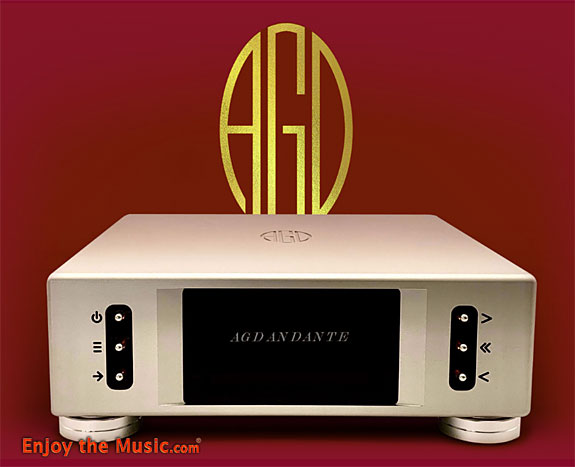
It is always an honor when a manufacturer asks me to review their product. It is, after all, their ‘baby’. They have poured their heart and soul into it. And often times, the smaller the company, the more heart and soul is to be found within. Such was the case with the AGD The Audion monoblocks to which I not only gave a very positive review, but also bought as my new reference. The Gallium Nitride Power MOSFETS in this Class D power amp were not only acoustically outstanding, but the visual design of these diminutive monoblocks also spoke to the tube-lover within me. I giggle with delight every time I bend over to turn them on and I listen with reverence to the music that now pours from my rig. Once the review was complete and I turned off my critical ears, I realized I had not raved loud enough.
It was a delightful, but ambivalent surprise when Alberto Guerra asked if I would like to review his new Andante preamplifier. Ambivalent — because I am a tube guy. That is to say, I tend to prefer the sound of tube gear, particularly SET designs. But I’m not an expert on different tube types and circuits. True, I’ve adopted his Class D monoblocks but retained my Coincident Statement Preamplifier and Phono Preamplifier, both outstanding tube designs. The Andante is solid-state and while I heard the prototype at the Rocky Mountain Audio Fest in 2019 where the AGD was among the Best Rooms at the show, I didn’t pay any attention to it. I was much more intrigued by the new The Audion monoblocks at the time.
There was also the thought that manufacturers like to return to reviewers who have previously given them positive reviews, perhaps thinking that they will likely get another. With new companies, a review can either make or break them — a fact that can be a disruptive force in either direction, particularly if it is from a major publication. With all this in mind, I said “Sure, send it along!”
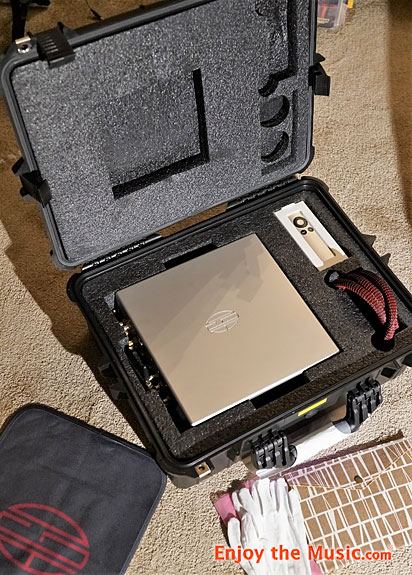
At this point, Alberto added that he would like to include a pair of his first product, the Vivace monoblocks, to show off the Andante in the best light. Oh dear, suddenly my workload doubled as I realized I would have to compare the Vivace with The Audion as well as the Andante preamp with my Coincidents. Two weeks later an attractive FedEx woman, who was becoming increasingly familiar during the COVID-19 lock-down here in Upstate New York, bounded up my driveway with a plastic shipping case in each hand, then returned with a third. After parting with a smile and a touch-free wave I ventured out to my front steps. “Whoa!” These guys were a lot heavier than my Audion monoblocks. Opening up the cases revealed foam encasement that was as fit for laboratory-grade equipment as it was for these fine audio components. It did not escape my eye that there was a second cylindrical hole in the foam—possibly for a future version of the power amp with two GanTubes and twice the power? I talked with Alberto about that later.
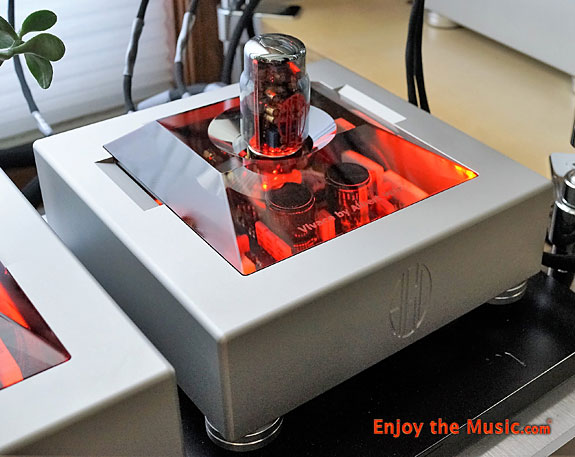
Unpacking a new piece of gear is an up-close-and-personal experience unlike what you usually have at a show. Both the Andante and the Vivace, though small, are dense. No chance either of them would float. Holding the Vivace in hand revealed a much finer fit and finish than the impression I had merely standing above it at shows. The beveled, tinted and engraved acrylic cover reveals the architecture of the circuitry within in dazzling detail. The amp is even more intriguing when powered up, illuminated from within by orange LEDs. It is this up-close view you get when you power it up that creates a personal relationship with the amp. The two-second delay between flipping the switch and the illumination within arrests your attention as it protects the amp from a possible surge of current. Likewise, the illumination of the GanTube itself is captivating and creates a welcome ambiance in a darkened listening room. This is not an amp to be hidden on the bottom shelf of a component rack. The orange glow, the beveled acrylic, and the fine sand-blasted and anodized finish demand to be put on display, preferably near an equally attractive loudspeaker. With the Vivace, contemporary design is elegant unlike anything else available today.
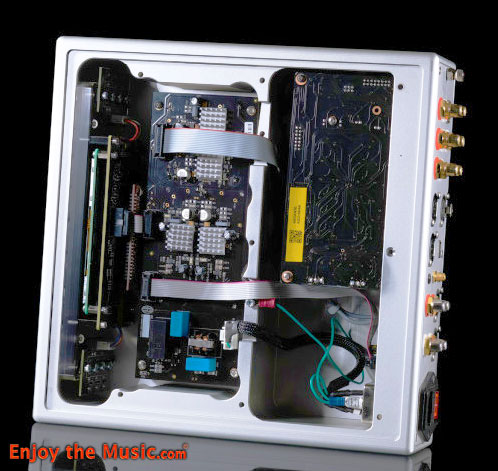
While the Vivace is bestowed with an elegant design, it has only one function to perform — driving the loudspeakers. The Andante has more business to take care of and its density is due to the compact size. It becomes even more impressive considering it includes a phono stage and streamer as well as a DAC. Inside, the PC boards are stacked four high and suspended to reduce vibration. Their relatively small footprint probably helps to reduce vibration as well. The chassis is machined from billet aluminum and the fit and finish is First Class all the way, matching the Vivace monoblocks.
A veritable firewall separates the audio circuits from the power supplies at the rear and the analog and digital circuits are likewise separated. The back panel containing all the connections is easily removed for service. The large screen on the front was easily readable from 12′ away at the listening chair. The numeric volume display was in 1″ tall digits and the lettering for the selected function was about 0.25″. A serif font is used which adds to the readability and lends a human touch to the component. An 8 bit fully balanced, passive ladder volume control with 256 steps permitted very fine adjustment from the front panel or the infrared Apple remote.

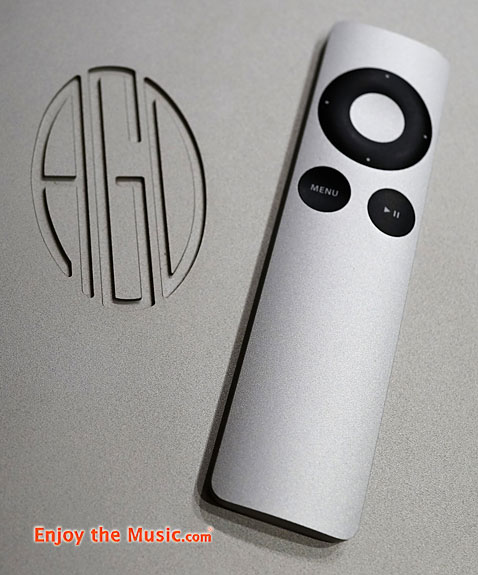
The AGD logo is engraved in the center of the top while the Andante model name emerges on the screen when you take the unit out of standby mode. Touch-sensitive switches, identified with symbols, are on both sides of the screen and the functions are also controlled by a slim Apple remote. For a guy who is normally infuriated by confusing remote controls, I found the system easy to learn and relatively intuitive. If I can learn to love it, you can too. The substantial and prominent feet anchor the Andante to the shelf with large inset o-rings providing a non-slip grip. The resolution of the Andante was so high that the addition of aftermarket footers was not needed with my Codia Acoustic Design rack providing very substantial isolation.
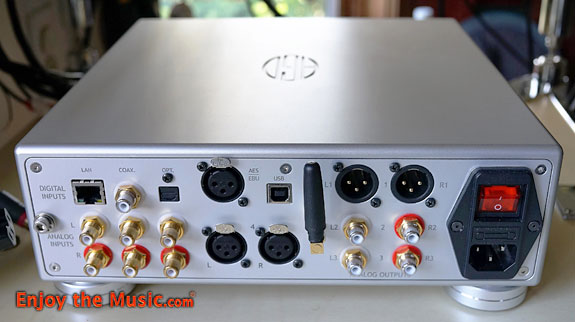
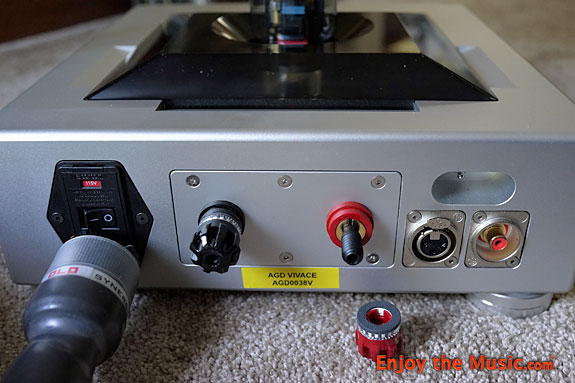
Walking around to the backside of the amp you can see that the chassis is carved from billet aluminum. Only four screws hold the back panel containing all the connections to the chassis. I decided not to go exploring here, given that I didn’t know the price of the Andante and I didn’t want to return it in pieces. (Alberto kindly supplied the studio photo of the internals, above.)
On the right side facing is the IEC input with a built-in fuse holder and power switch. The unit fires up from standby mode with the touch-sensitive switch on the front so you don’t need to use this unless you are reconfiguring your rig somehow and need to shut it down completely. Keeping the Andante in Standby mode allowed me to dive right into the music without waiting for warmup to achieve an optimum sound quality as I do with my tube gear. The fuse holder combined with the power switch is much easier to access than on the Audion power amps. Unlike my other components which are outfitted with Synergistic Research Orange fuses, I retained the stock fuse for this review. My experience with the Orange fuse suggests that by adding one you will achieve even finer musical results. I should also note that I used my Synergistic Research power cords for this review. From previous experience, I knew the red power cords supplied with the amps were considerably better than the generic cords often supplied with gear, but the Synergistic were superior still.
To the left of the IEC inlet are three sets of outputs — balanced on top, and unbalanced below. Unlike many preamps, they are all arranged with the left channel on the left and right channel on the right, possibly requiring the cables to cross en route to their respective monoblocks. With the two sets of RCA outputs arranged horizontally, rather than red on the bottom and white directly above it, as is common practice, you have to pay attention. You can imagine my “Oh, damn” moment after I was swapping preamps and the left channel was dead because I put both my interconnects into the two red RCA outputs. Maybe I should have mounted a mirror on the wall behind the rack when the room was redecorated?
Moving to the left in the photo, the vertical black object is a Bluetooth antenna. Yup, one of these days maybe I’ll get around to Bluetooth. The good news is this will make your rig “family friendly” when your kids (adult kids and otherwise) want to listen to music from their phones or tablets.
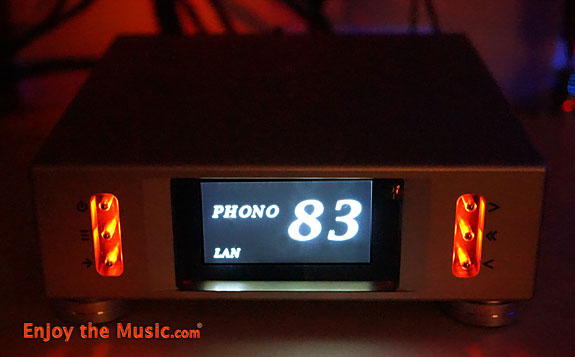
The next five inputs across the top are various digital inputs for the built-in DAC and streamer. They are selectable from the touch-sensitive buttons or the remote control. Everything you could need from LAN to USB. A high-quality LAN connector leads directly to the streamer as this is acknowledged to be the most simple and best way to transfer that data. Wi-Fi connection to the streamer is not an option.
Below the row of digital inputs, the one pair of balanced inputs is once again arranged with the left on the left as you face the amp from behind. The three sets of RCA inputs are arranged normally with the right (red) channel below the left. The far-left set is the phono input with its ground post just a bit further to the left near the edge of the back panel. When scrolling through the inputs with the remote, the inputs appear, one at a time, in smaller type in the bottom left side of the screen.
The inputs are not customizable (re-nameable) which many may find unfortunate in a component of this caliber. I didn’t find this to be much of a problem but many less expensive components do permit naming of inputs. RCA 1 shows up as “Phono”, then RCA 2, RCA 3, XLR, B_TH, COAX, OPT, AES, and LAN follow. Infrequent users, if you let them near your rig at all, might benefit from a listing with a correlation of inputs with sources. It need not be a Rosetta Stone.
With my tight-knit rig I run unbalanced interconnects with 7′ speaker cables so I did not evaluate the Andante in balanced mode. Conventional wisdom suggests it could get slightly better using balanced cables, given the same quality wire. I did use balanced interconnects for my external DAC as that is how I run my DAC normally. The Andante itself is fully balanced from input to output.
Integration Concept
The Andante is a unifying control center in an era where competition among sources seems to be fracturing traditional categories. You could have a separate box for each function (DAC, streamer, phono stage and line stage) requiring additional interconnects and power cords at hundreds, if not thousands, of additional dollars per unit. With the built-in phono stage, streamer and DAC, the Andante will accept a single connecting cable from your laptop, network or CD transport, as well as pairs of inputs from your turntable, tuner, CD player or tape deck. And there is Bluetooth at 24-bit/48kHz with aptX if you want to go wireless. All the bases are covered should your choice of source evolve or proliferate in the future. Further, you can even go balanced throuhout with your primary source if it has balanced outputs. With the balanced output of the Andante you can also indulge in long runs of interconnects to distant power amps by your speakers if they, too, are balanced.
With the two sets of unbalanced outputs, you can easily bi-amp your speakers if that’s your pleasure and the manual suggest you can even have custom crossover points installed by request. The important point here is that the Andante addresses all the major sources in a single box. It is unlikely that you will outgrow it. And if a new mysterious or esoteric source arises, it is likely you will still be able to run it through the Andante. It is not an “all-in-one” box in that you still have to supply your sources and you still choose power amplifiers that are appropriate for your speakers, room size and listening habits…or even active speakers, which are receiving more interest these days.
The DAC
Rather than follow the traditional route of using an AKM or ESS chip in a classical application, Alberto chose to be his own drummer. He chose to use four R2R industrial-grade chips to receive the digital stream from a receiver-decoding-up-sampling circuit comprised of an FPGA and AKM4137 sample converter IC. Everything gets re-clocked by an onboard master reference oscillator and everything is up-sampled to 32-bit/384kHz.
Using my lightly modded vintage Sony CDP-X77ES CD player as a transport and Synergistic Research Atmosphere Alive digital cable w/grounded shield, I compared my highly regarded Calyx 24-bit/192kHz DAC with ESS 9018 chipset and their substantial external power supply with the built-in DAC in the Andante. Granted, my roughly $2000 Calyx is modded with ERS paper and AVM goop and sits atop Synergistic Research MiG SX footers and is fed with a Synergistic Research digital power cord that cost as much as the DAC. I mention this not to brag, but to assure you that it sounds a good bit better than a $2000 DAC right out of the box. And it gives you a price reference to help establish the value of the Andante. I still don’t know what the Andante costs at this point but my listening revealed the internal DAC to be a bit better than the roughly $5500 value of the DAC, power supply, power cord, and footers. I’ll get around to describing the sound of the AGD gear further on.
The Phono Stage And FryBaby 3 Burn-In Device
The phono stage supports both moving magnet (MM) and moving coil cartridges (MC). To make the selection you need to go to the second page within the menu. It’s easy. If I can do it, you can do it too. The MM is 47kOhm impedance with a claimed signal to noise ratio of 80dB. The MC impedance is fixed at 420 Ohms with a claimed S/N ratio of 70dB. I ran my heavily modded Linn LP12 with my Charisma 103 cartridge, which at $800 is my daily driver. While true analog lovers with a variety of cartridges might yearn for a phono stage with multiple loading values, the 420 worked fine with Charisma’s upgraded rendition of the Denon DL-103R cartridge. How did it compare with the now $6500 price of my tube based Coincident Statement Phono Preamplifier?
There was greater resolution overall and I noticed some greater deficiencies in the 103 than I experienced with the Coincident Phono and Line preamplifiers. The bass was tighter and the treble more extended and resolved. I suspect these gains had as much to do with the line-level preamplification of the Andante as the phono stage itself. I was so impressed with the overall presentation of playing familiar LPs that I yearned to try my more expensive cartridge, but did not have time to continue the break-in process on that cart. I’ll have more to say about phono playback further on.
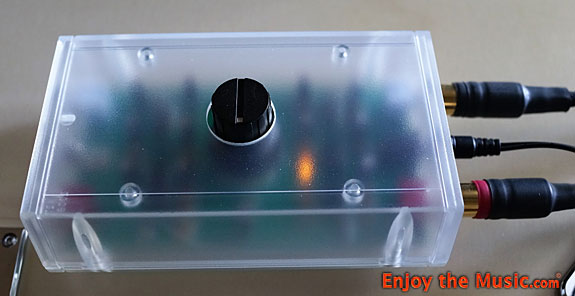
I also want to express my gratitude to Jim Hagerman of Hagerman Audio Labs for the use of his FryBaby3 burn-in device. While most audiophiles will use the FryBaby3 to burn-in interconnects, it can also be set to burn in phono stages, line stages, and amplifiers. This freed up at least a hundred hours of playing LPs, not to mention the wear on my cartridge. It doesn’t look like anything special but looks can be deceiving. By itself, it did a very decent job as I could just plug it into the Andante and let it go for 24 hours. It only took playing a couple more LPs for the rig to be sounding perfectly smooth and open — or maybe it was just my ears adjusting to the new analog sound of the Andante. Two thumbs up!
The Streamer
I’m not going to pretend I know much of anything about streaming, so I’ll just let you know that the Andante is good to go with DNLA, UPnP, ROON, AirPlay, TIDAL, Qobuz and it is MQA compliant. And as I said earlier, it is accessed via the LAN port. That sounds pretty complete to me. If you need something other than that, you’re probably building your streamer.
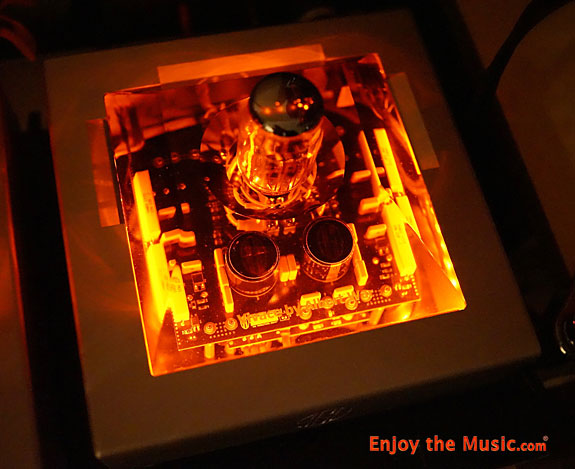
ADG Vivace Monoblock Amplifiers
The Audion monoblocks won me over with their tube-like design, their superb sound and their price, lying just at the edge of my financial comfort zone. The Vivace presents an entirely different contemporary design that, while unique, also adds to the cost. But at twice the price of the Audion, you not only get an extraordinary design, but you also get more of an extraordinary musical performance found in the Audion. The Gallium Nitride power MOSFETS in the Class D power stage encased in the GaNTub have a very high slew rate with little overhang ripple at the top of the square wave signal. The switching is extremely fast and the attack of notes is immediate, yet not etched or subject to ringing. Music just happens the way it does in real life. With the noise floor down 130dB and a dynamic range of 120dB, the dynamics approach those of live music. Likewise, inner detail, tonal color, and microdynamics excel. In these aspects, it is identical to the Audion, but the much larger power supply and somewhat greater power of the GaNTube 88 (200 Watt @ 4 Ohms versus 170 Watt @ 4 Ohms) take the Vivace far beyond the Audion.
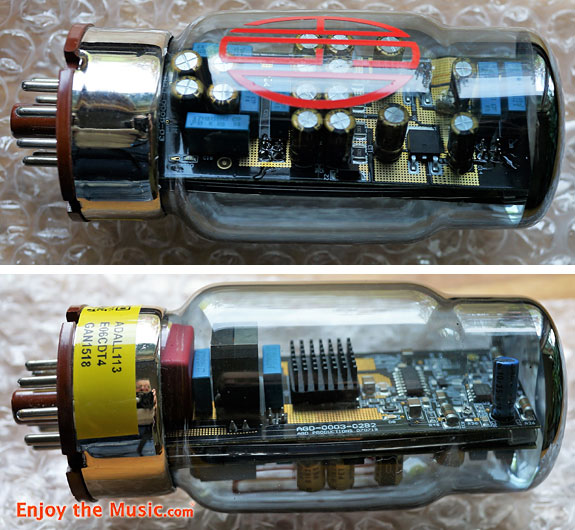
Comparing the two, the music, like the amps themselves, is lighter weight with the Audion. (6.5 pounds for each Audion versus 22 pounds for each Vivace.) The soundscape is equally broad, but the musicians seem more firmly anchored in place with the Vivace and there is a greater sense of physicality, not only in the musicians and the music, but of the space among the players — more room tone, if you will. The atmosphere of the venue becomes more prominent in live performances, whether rock ‘n roll, jazz, or classical. With the larger power supply, there is also greater control of power passages, whether crescendos in rock, classical or deep organ. Sustained notes extend without wavering. The similarity to tube amplifiers is uncanny with smooth, three-dimensional notes, particularly when used with a tube preamp.
What this adds up to is greater involvement with the music. It takes less mental energy to convince yourself that you are listening to live music and the music reaches out to you and pulls you in with realism that I have rarely heard before — and only in much more expensive systems, or with music that was not complex. This is not the pull of romantic musicality such as you get with a high-efficiency speaker driven by a 2A3 SET amp, but the pull of seemingly live music being performed in front of you right at home. This was my response to the Vivace driven by my Coincident Statement Line Preamplifier and Statement Phono Preamplifier. But read on. The story gets even better, and perhaps even worse.
AGD Andante Stereo Preamplifier
Combining the Andante first with the smaller Audion monoblocks, I noticed listening to the Pittsburgh Symphony on WQED, Leonard Bernstein conducting the symphonic dances from West Side Story, the music literally danced around the stage on the broad soundstage in my room as the music emanated from different sections of the orchestra. (The broad soundstage is typical in my room due to the placement of speakers on the long wall.) The attack of percussion instruments was more prominent than typically heard from further back in the theater and the ambient room tone and audience noise was absent, indicating the close mic’ing of the orchestra and the extended treble of Andante. The orchestra itself sounded very “live” but the recording put you closer to the stage than you might ordinarily sit. This revelation of the “truth of the recording” can be thrilling in the case of great recordings, or less than great with poorer ones.
Running my turntable through the Coincident phono stage into an Andante line input the extended treble of the Andante revealed clicks on a garage sale copy of ZZ Top’s “Blue Jean Blues” (even after cleaning a second time) that are normally obscured by my Coincident line stage. The piece had nice bloom, but I wasn’t romantically sucked into this song the way I normally am with the tube preamp.
On Jackson Browne’s “The Load Out” and “Stay”, I appreciated the higher resolution, especially with the lyrics, and heard no clicks, but the clean presentation had a feeling of being in the mixing booth rather than in the concert hall of this live recording. There were a lot more transparency and detail as well as a stronger bass and treble than I heard with my tubes. On a 180 gram relatively new LP, Mario Rom’s Everything Is Permitted, the resolution was exquisite. His very fast playing on the trumpet, as well as the full and tonally correct music of the bass player were captivating, easily reminding me of the two times I’ve seen them live at the Rochester International Jazz Festival.
Switching over to the bigger Vivace monoblocks with the Andante preamp, The Mario Rom LP sounded fuller, more recessed, and a little warmer. Adding Synergistic Research MiG footers made it slightly sharper but didn’t significantly alter the presentation. With “Blue Jean Blues” there was more bloom and more involvement as well as an increased focus beyond what my tube preamp supplied. Similarly, with the Jackson Browne cut, there was better focus than with the tube preamp, but the Vivace, with its fuller sound, was more tube-like than the Audion. When the music builds up, it is more forceful with the Vivace. It has more weight and it flows without effort whether the sustained note comes from a low note on a pipe organ or a high note on a Hammond B3.
The Dance Of Four
There is no dearth of choice in high-end audio, nor is there a common goal. One of the most difficult tasks we all have is to figure out exactly what we want our music to sound like…and the constant evolution of products (and even formats) can make our personal goal a moving target. That’s what happened when I discovered the AGD room at the Chicago show. With the speakers of Alan Sides there was an immediacy and live-ness that captured my attention. I wanted a piece of that achievement for my rig, but it wasn’t until RMAF 2019 in the fall of the year that the right form and price point emerged. The Audion blended in extremely well with my tube preamps and pulled me half-way across the line into solid-state amplification. In this review, I was allowed to explore the possibility of going all the way with solid-state. Here’s what I found worked for me…and what didn’t. But as you read this, keep in mind that my findings and preferences are only guideposts to help you find what might work best for your goals.
Combining the Andante preamplifier with Eddie Wong’s monoblocks with parallel 300B tubes didn’t work for me at all. It was a step back in tube amplification that surrendered the deep and tight bass as well as the extended and refined treble that I had gained with The Audion monoblocks. Sure, I was reminded of the magical emotional midrange of the 300B tubes, but the top to bottom increase in resolution of the AGD provided an ease in cognitive recognition of lyrics and delight in hearing precise notes, as well as increased transparency that made the music even more inviting.
Combining the Vivace monoblocks with my Coincident preamplifiers took my rig up another significant notch with the greater control, the fullness of sound, and richness of tonality the more powerful Vivace offered over The Audion. Either of these power amps in combination with the tube preamp provided a lively but relaxing listening experience that could set my toe-tapping for hours on end, day after day. While I appreciate the style of the Vivace, I’m personally more intrigued and delighted with the polished aluminum finish on the tube-like architecture of the Audion. And I’m a lot more comfortable with the price of the Audion. No shame there; audio is not my only interest.
Combining the Andante preamp with either The Audion or the Vivace the musical experience became very immediate with incredible transparency, resolution, dynamics, and all the minor attributes that give you the “You Are There” experience. The music achieves a presence that commands your attention in much the same way as attending a live performance. And depending on the music, that can be as physically and emotionally demanding as it is exhilarating. This is probably not the combination you want to listen to at the end of a long hard day at work, but exactly what will thrill you if you crave live music but are constrained by a pandemic or happen to be living in Medicine Bow, Wyoming, many miles from your nearest philharmonic orchestra or jazz club.
This was the kind of aliveness and immediacy that I heard at Axpona with the Allen Sides speakers and it is the kind of sound you would expect from a loudspeaker designed for a recording studio by one of the top engineer / producers in the music industry. Later, at RMAF in September, the Vivace and the prototype of the Andante were combined with huge, world-class Sigma Acoustics speakers created by Aldo Zaninello. Both rooms were among the Best Rooms at their shows, but the comparison revealed the importance of the room and the loudspeakers for the resulting music.
The larger than life Sigma speakers in a larger than life room created a larger than life musical experience. In my own experience at home, the AGD Andante preamp and Vivace monoblocks took my Kharma speakers to the highest level of resolution and live musical presence that I have yet heard. If you prefer your music less extraordinary, you will have to mix and match the AGD amplifiers with other manufacturers, or tune your turntable with other cartridges, or tune your rig with other cables, or tune your room with alternate décor. While this may seem like this preamp and these monoblocks are demanding components, the rewards of such attention to detail are amazingly lifelike.
Value
Before I finally took a look at the price of the Andante, I estimated its cost to be somewhere between $12,000 and $18,000. The $15,000 price of the Vivace monoblocks seemed to be a clue to the price of the preamp. As it turns out, the standard sandblasted and anodized finish is $12,999 and the polished aluminum version is $13,999. The high side of my guesstimate takes into account the value of my roughly $6k DAC and $6500 phono stage. Adding in the price of a streamer and subtracting out the cost of multiple chassis, power cords and interconnects and the $18,000 figure seems reasonable for the high-quality construction and sound that it provides. The actual $13,000 price seems like a strong value when you consider the extra shelves you don’t need for a rack, or that you may not even need a rack at all. Like my Linn turntable which weights a bit more and has a larger footprint than the Andante, a secure wall shelf anchored to studs may be all you require.
The consolidation of so many functions and features in such a compact component will add significant value to those living in smaller quarters or listening in smaller rooms. Add whichever sources you desire, plus the appropriate amp for your speaker and room, and you have a relatively compact system built around this multi-purpose hub.
With the Vivace and The Audion monoblocks, you have compact, cool-running amps that will drive most speakers in most reasonable size rooms while contributing style that should make their owners proud. As I said in my review of The Audion, they bring Class D amplification into the upper echelon of high-end audio.

Going Forward
In a conversation with Alberto, he shared with me what he is cooking up in his “Italian kitchen” in California. He wants to reach out to a broader base of people who loved the sound of his amps, but were either intimidated by the extraordinary designs, or constrained by vertical shelf space or rampant rug rats who will ultimately need new clothes when the pandemic is over. New, additional power amps are in various stages of design, both monoblocks and stereo, as well as an integrated amp and a headphone amplifier, using a more basic box design. I expect they will be similar in size and appearance to the Andante to strengthen the identity of the brand and will likely emerge over the next year or two. While this will bring the cost down, do not discount the value of fine design. Good taste in life is often expressed through the good design of things you own.
On the immediate horizon, possibly as early as December, is the new AGD Gran Vivace monoblock with the new KT150 GaNTub that will put out 350 Watt @ 4 Ohms. Additionally, he is working on a new GaN34 GaNTub based on the EL34 tube shape that will put out something like 120 Watt @ 4 Ohms. So the GaNTub series will continue to develop as well.
The Grand Finale
Generally, I leave the flamboyant remarks for younger writers. These three products I’ve reviewed from AGD represent a mature and learned approach to high-end audio that belies the brief time they have been on the market. It is no surprise that Alberto Guerra is Italian by birth. His amps are not examples of form following function, but of form exuding the passion of their designer, all in pursuit of a commanding musical experience for the listener. The resolution, transparency, and dynamics they bring to the event creates a musical presence that is difficult to ignore.
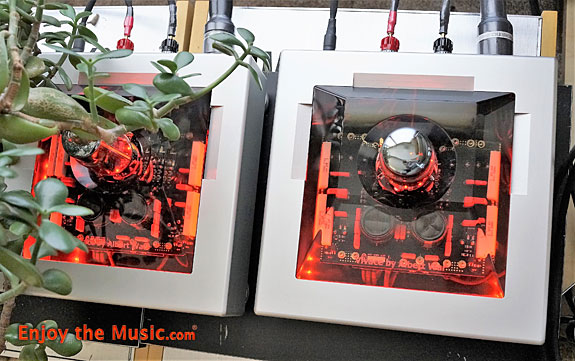
If you prefer to relax and read while you listen to music, you will have to de-tune and romanticize your source components. If you’d rather attend the performance and engage with the music and the performers who are creating it, AGD will take you to the venue. And if you’ve developed a personal taste for design as sophisticated as your ear is for music, and the design of these components resonates with your style, you will experience a pride of ownership that is typically reserved for only the most expensive brands.
If you prefer being unique and to follow your own path, AGD’s Andante stereo preamplifier and Vivace monoblocks amplifiers have my highest recommendation! The accolades continue to mount for this fine American manufacturer whose future looks very promising.
| Andante Preamplifier | |
| Tonality | |
| Sub-bass (10Hz – 60Hz) | |
| Mid-bass (80Hz – 200Hz) | |
| Midrange (200Hz – 3,000Hz) | |
| High Frequencies (3,000Hz On Up) | |
| Attack | |
| Decay | |
| Inner Resolution | |
| Soundscape Width Front | |
| Soundscape Width Rear | |
| Soundscape Depth Behind Speakers | |
| Soundscape Extension Into Room | |
| Imaging | |
| Fit And Finish | |
| Self Noise | |
| Value For The Money |
| Vivace Monoblock Amplifier | |
| Tonality | |
| Sub-bass (10Hz – 60Hz) | |
| Mid-bass (80Hz – 200Hz) | |
| Midrange (200Hz – 3,000Hz) | |
| High Frequencies (3,000Hz On Up) | |
| Attack | |
| Decay | |
| Inner Resolution | |
| Soundscape Width Front | |
| Soundscape Width Rear | |
| Soundscape Depth Behind Speakers | |
| Soundscape Extension Into Room | |
| Imaging | |
| Fit And Finish | |
| Self Noise | |
| Value For The Money |

Check out Enjoy the Music!
See many great reviews by Enjoy the Music.com at this link.
Specifications
Andante Specifications
Phono Input: Moving magnet and moving coil
MM Input Impedance: 47 kOhm
MC Input Impedance: 420 Ohm
RIAA Accuracy: <0.5dB
Frequency Response: 20Hz to 20kHz
THD%: ≤0.03%
Analog Inputs: Two unbalanced RCA, one balanced XLR inputs
Frequency Response: 1Hz to 100kHz
Analog Outputs: Balanced XLR and two pairs of unbalanced RCA
Output Impedance: <50 Ohm
Frequency Response: 1Hz to 100kHz
THD+N (Balanced): ≤0.005%
THD+N (Single Ended): ≤0.009%
SNR: ≥110dB
Digital Inputs: USB, AES/EBU XLR, S/PDIF coax, optical TosLink, DLNA 1.5, and Ethernet
Chipset: XMOS XU208
Frequency: 44.1kHz, 48kHz, 88.2kHz, 96kHz, 176.4kHz, 192kHz, 352.8kHz, 384kHz, 705.6kHz, 768kHz
Resolution: 16, 24, and 32 bit.
DSD64 (2.8224MHz and 3.0720MHz), DSD128 (5.6448MHz and 6.1440MHz) and DSD256 (11.2896MHz and 12.2880MHz), DSD512 (22.5792MHz and 24.576MHz).
Streaming Functionality DNLA, UPnP, ROON, and AirPlay (via LAN port)
Bluetooth: aptX
Dimension: 11″ x 11″ x 3.5″ (WxDxH)
Remote: Infrared
Trigger Output: 12V, 0.1A DC (at customer’s request)
Weight: 22 lbs.
Price: Andante Pre-DAC Streamer Phono $12,999
Andante SE $13,999 polished finish
Vivace Monoblock Specifications
Output Power: 100 Watts @ 8 Ohms, 200 Watts @ 4 Ohms
THD+N: <0.005%
Frequency Response: 5Hz to 100kHz
Output Noise: ≤ 45μV (A-weighted)
PWM Frequency: Up to 768KHz
Dynamic Range: 120dB
Dimensions: 11″ × 11″ x 5″ (WxDxH)
Weight: 22 lbs.
Price: Vivace $15,000 pr. monoblock
Vivace SE $16,500 polished finish
Company Information
AGD Productions
2644 Via Valdes
Palos Verde Estates, CA 90274
Website: www.AGDproductions.com

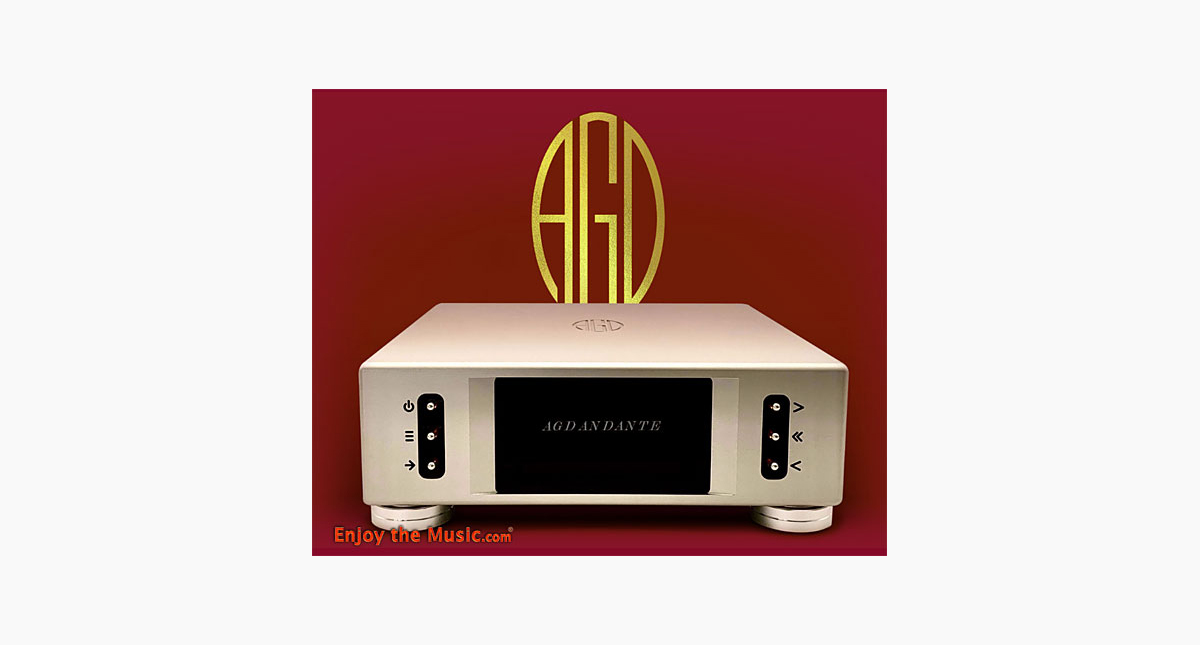






Leave a Reply
Want to join discussion?
Feel free to contribute!